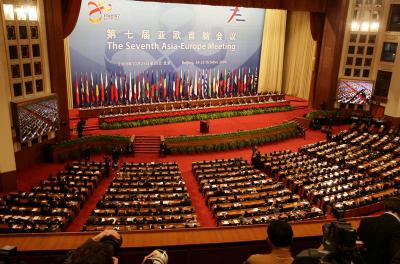Europe and Asia needed a new bridge. Over the past 10 to 15 years, ASEM has laid this important foundation, acting as an umbrella framework for cooperation between the two regions. ASEM’s existence accelerated the process of developing bilateral relations. In short, ASEM played a significant role in strengthening and mainstreaming Europe-Asia cooperation.
It is ironic that ASEM now stands at the crossroads due to its very success. Europe-Asia cooperation is now a fact of life and people no longer feel the need for ASEM as a catalyst or bridge. ASEM covered economic, political and socio-cultural affairs in the past, whilst now facilitating trade and economic relations are the areas of international relations interest.
In the meantime, the EU is moving from an inter-regional approach to a bilateral one in its trade strategies toward Asia. Brussels originally tried to conclude a region-to-region FTA with ASEAN as a partner. That idea was mostly abandoned, although it remains the ’ultimate objective’ according to the European Commission. Instead, the EU is now active in negotiating FTAs with individual countries in the region, and seeking to deal with such major powers as China, India and Japan primarily in bilateral terms as well.
Core issues of trade and economic relations between Asia and Europe are increasingly being addressed in a bilateral manner. The role of ASEM inevitably diminishes in these areas as a result. Given the diversity of members’ interests, and the ever-increasing number of member countries in the club, it should be of no surprise that substantial issues of trade and economy need to be addressed elsewhere for the sake of efficiency and effectiveness.
But this is not the end of ASEM, nor is it time to be complacent as this framework can be revived and reinvigorated. There are new areas for ASEM activities requiring the framework to be more flexible.
Firstly, ASEM can play a bigger role in security. This is an area difficult for ASEM to address due to diverse interests and values among its membership. Since the September 2001 terrorist attacks against the US, awareness that security in Asia and security in Europe are linked has developed. Given that trade and economic relationships between Europe and Asia are vital, and that these are heavily dependent on safe sea lines of communication (SLOC), there is every reason for ASEM to contribute in this field. Maritime security and SLOC protection have a wide scope.
Actual planning and coordination of anti-piracy operations in this theatre are not traditionally ASEM’s business. Many ASEM countries already actively participate in international efforts there through ATO, the EU and on a national basis. The UN-led contact group is available for multilateral and inter-institutional coordination. Nevertheless, ASEM can play a role in helping Asian countries contribute more to protect the SLOC routes between Europe and Asia. The issue of anti-piracy is being discussed more in the ASEM framework in the run-up to the October summit.
Second, in the areas of trade and economy, ASEM can function as a venue for research. Valuable areas of study may include the economic impacts of trade and investment liberalisation and facilitation between Europe and Asia, and the impact of bilateral trade deals between members. ASEM can also be used to ensure transparency and monitor trade and economic relations between Europe and Asia.
Particularly important is monitoring European and Asian preferential trade arrangements, such as FTAs, between countries to prevent discrimination and distortion of the wider picture of trade between the two regions. The Asian Development Bank (ADB), OECD, WTO and other relevant organisations should also be welcome to participate in these activities. Those tasks are indispensable as a foundation for the development of sound and transparent trade and economic relationships between Asia and Europe. ASEM is well placed to assume such a responsibility.
Looking at a broader picture of Asia-Europe relations, many cooperation projects are taking place outside the ASEM framework. This is only natural and should not reflect poorly on ASEM as it is a sign that the overall relationship between the two regions is maturing. ASEM was not intended to monopolise Asia-Europe relations, but to bridge and assist.
For ASEM members, the framework would also be expected to provide an opportunity to attract more participants to various cooperation projects, including those not led by ASEM. As a matter of principle, ASEM does not need to be a self-contained grouping. Cooperation among individual ASEM members on anti-piracy and other aspects of maritime security can fit into this new model. Again, these do not have to be exclusive ASEM projects. More important than a distinctive ASEM footprint on each project is the extent to which ASEM can facilitate effective cooperation between countries in Europe and Asia. Flexibility is the key. The greater its flexibility, the more attractive ASEM can be as a tool for member countries to use, ultimately bringing more value to ASEM.
Cooperation for the sake of cooperation without substance cannot be sustainable in the long run. We need to have a clearer picture on which areas ASEM has a comparative advantage over other frameworks and how members can use ASEM as an effective policy tool. There is certainly much work to be done between Asia and Europe, and ASEM has no time to waste.
Michito Tsuruoka is a research fellow at the National Institute for Defense Studies (NIDS), Ministry of Defence, Japan.

